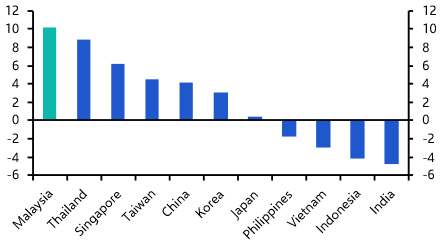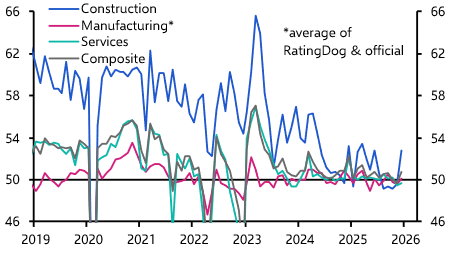Concerns that one legacy of the pandemic will be a period of higher inflation are starting to spread. According to Eurostat, HICP inflation in the euro-zone jumped from -0.3% in December to +0.9% y/y in January. Core inflation increased from 0.2% y/y to 1.4% y/y – by far the largest monthly rise on record. In Germany, the region’s largest economy, core inflation hit +2% y/y. Up to now, the US has been the focus of concerns about inflation. But we now think both the US and the euro-zone will experience broadly similar rates of headline inflation over the next 12 months. (See Chart 1.)
Chart 1: Consumer Price Inflation (% y/y)

However, the underlying inflation dynamics in each region are very different.
In the euro-zone, almost all of the rise in inflation in January can be explained by factors that are likely to prove transitory. The list is long, ranging from the cancellation of January sales, which pushed up clothing inflation, to an adjustment in the HICP basket to reflect changes in consumption habits caused by the pandemic. In Germany, this was amplified by the reversal of last year’s emergency VAT cut and a hike in the carbon tax. The importance of each of these in driving up annual inflation varies, but in every case the effect will be temporary. We expect euro-zone inflation to drop back next year and average less than 1% in 2022.
The factors that point to a sustained rise in inflation in the US are not present in the euro-zone. For one thing, the scale of fiscal support is much smaller in Europe. According to the IMF, since the start of the pandemic fiscal measures aimed at supporting aggregate demand, such as increased unemployment insurance and stimulus cheques, have totalled 16.7% of GDP in the US. Add the proposed Biden stimulus package to this and the total reaches as much as 25% of GDP. In contrast, the equivalent figure in major euro-zone countries ranges from 4% (Spain) to 11% (Germany). The scale of fiscal support in the euro-zone is simply not in the same league as that of the US. (See Chart 2.)
Chart 2: Fiscal measures to support aggregate demand in response to the pandemic (% of GDP)

At the same time, the degree of economic slack is probably smaller in the US than it is in the euro-zone – meaning the amount of fiscal stimulus that the economy can absorb before running into capacity constraints and generating inflationary pressure is smaller too. The normal way to judge this would be to compare the size of output gaps. However, as we’ve noted before, the pandemic has made these a useless tool for thinking about spare capacity and the subsequent need for policy support. This is because current shortfalls in output are primarily due to restrictions on the supply-side of economies, resulting from lockdown measures, rather than the weakness of demand. Instead, we must use other ways to measure spare capacity, including business surveys. These consistently suggest that there is more slack in Europe than in the US. For example, firms in the euro-zone (as well as the UK and Japan) are finding it much easier to fill positions than their counterparts in the US. (See Chart 3.)
Chart 3: Measures of How Easily Firms Can Fill Positions (Std. Dev. From Long-Run Average, 3m Av.)

In other words, the US economy is not only on the receiving end of a much larger dose of stimulus than the euro-zone, but it also has less space to absorb that stimulus without generating inflationary pressures.
Beyond the size of stimulus and the extent of spare capacity there is a more fundamental point here. Milton Friedman said that inflation was “always and everywhere a monetary phenomenon”. That has become the source of much debate, but what is more difficult to argue against is that inflation is always and everywhere an institutional phenomenon. A sustained rise in inflation only occurs if policymakers allow it. And the willingness of policymakers in the US and Europe to embrace inflation is very different.
The Fed has made it clear that even with a huge fiscal package coming down the track, it will not slow the pace of its asset purchases until next year and that interest rate hikes are still several years away. A couple of factors make it easier for the Fed to err on the side of providing too much support and tolerating moderately higher rates of inflation if that is what follows. The first is its move to targeting an average inflation rate of 2% over time – allowing for the recent undershoot to be followed by an overshoot later on. The second is its dual mandate, which requires it to achieve “full and inclusive employment” as well as price stability.
The situation in the euro-zone is different. The ECB is midway through a review of its monetary policy framework. The outcome is still uncertain, but there is little chance of the ECB shifting to a dual mandate in which full employment features as a secondary goal. Instead, it is more likely that it will shift its inflation target from “below but close to 2%” to a simple and symmetric 2% target. This would leave it looking extremely timid compared to the Fed.
All of this matters because the euro-zone is arguably in greater need of a dose of inflation than the US. For one thing, notwithstanding the transitory jump last month, inflation in the euro-zone has become lodged at a much lower rate. At the same time, this has happened despite the fact that nominal interest rates have been pushed to their effective lower bound. This leaves the ECB with little room for manoeuvre. A better way to deliver the same level of real interest rates would be to run a higher rate of inflation and nominal interest rates.
What’s more, depending on where it emerges, a period of higher inflation in some countries could help to address internal imbalances in the euro-zone. A faster rate of inflation in Germany may hurt its savers, but it is probably the least painful way to engineer a realignment of real exchange rates in the single currency zone.
As things stand, however, the rise in German inflation in January looks more like a blip than the start of a new trend. One legacy of the pandemic may well be higher inflation in some countries. But when the inflation revival comes, it is more likely to be in the US than the euro-zone.
In case you missed it:
- Our UK team sets out what to expect from this week’s Budget. After the Chancellor’s speech we will post a short podcast-style digest of the measures and what they mean – if you have any questions you would like us to cover, get in touch here.
- Our Senior Markets Economist, Oliver Jones, explains when, and when not to, worry about rising bond yields...
- …and our Chief EM Economist, William Jackson, assesses the macro implications of last week’s bond rout for emerging economies.



